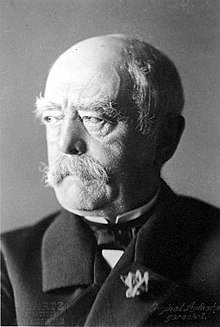Bismarck model

The Bismarck model (also referred as "Social Health Insurance Model") is a health care system in which people pay a fee to a fund that in turn pays health care activities, that can be provided by State-owned institutions, other Government body-owned institutions, or a private institution.[1] The first Bismarck model was instituted by Otto von Bismarck in 1883 and focused its effort in providing cures to the workers and their family.[2] Since the establishment of the first Beveridge model in 1948, where the focus was into providing healthcare as a human right to everyone with funding through taxation, nearly every Bismarck system became universal and the State started providing insurance or contributions to those unable to pay.[3][4]
History
[edit]After the formation of the German Empire in 1871, Chancellor Otto von Bismarck experienced opposition from German Democratic Socialists. In response, anti-socialist legislation was passed in 1878, and Bismarck made the decision to incorporate social protection schemes into his budgetary planning.[5] Three major pieces of legislation that established state social insurance[6] were the Compulsory Insurance Act of 1883, the Accident Insurance Act of 1884 and an old-age and disability pension system that was enacted in 1889 and began in 1891.[5][7][8]
Implementation
[edit]Unlike single-payer healthcare, the state does not directly insure the population through a single publicly-owned insurance provider. Instead, all residents are mandated to enroll in one of several publicly- or privately-managed insurance funds to ensure universal coverage. Community rating protects insurance applicants from sale and price discrimination, while risk equalization subsidizes providers that are forced to insure high-risk individuals. Governments will also use all-payer rate setting to fix prices at private healthcare providers.
Examples
[edit]States such as Germany, Austria, Switzerland and Czech Republic have Bismarck healthcare, while states such as South Korea[9] and the Netherlands,[10] while having a basic state insurance, have a much stronger private presence in the healthcare providers and insurance systems.[11]
In Europe, countries like France, Hungary and Slovakia, while theoretically Beveridge system, have some degree of Bismarck politics in their laws.[12] Some in Italy argue that the Lombard socio-health system, which prescribes equality between the private and public sector and payment by performance, has some typical characteristic of a Bismarck system.[11]
Advantages
[edit]The Euro health consumer index calls the statement "Bismarck beats Beveridge" a "permanent feature" since 2014. Bismarck systems usually have significantly higher accessibility, lower waiting times and, thanks to the competition between operators, higher quality and more consumer-oriented healthcare.[13]
Studies show that the introduction of the Bismarck system in Germany led to a significant drop in mortality.[14]
Criticism
[edit]Since in the Bismarck health system the core financing are contributions, people in poverty can't pay and get limited coverage. In some countries, like Switzerland, the cost of insurance is high and continues to grow, leading part of the population to be under-insured.[15]
Another criticism is that since institutions are paid by performance some isolated localities may have little hospital coverage. [1]
While primary care is significantly faster to get in a Bismarck system than in a Beveridge system some argue that some elective care may be slow to get even in a Bismarck system than in a free-market healthcare, like the US.[1]
See also
[edit]References
[edit]- ^ a b c Nguyen, Angeline (5 August 2017). "International Health Care Systems Part 3: The Bismarck Model". Morning Signout. Retrieved 30 August 2024.
- ^ Sawicki, Peter T.; Bastian, Hilda (2008). "German health care: a bit of Bismarck plus more science". BMJ. 337. doi:10.1136/bmj.a1997. PMID 18996937. Art. No. a1997.
- ^ L’EVOLUZIONE DEI MODELLI SANITARI INTERNAZIONALI A CONFRONTO PER COSTRUIRE IL SERVIZIO SANITARIO NAZIONALE DEL FUTURO (Report) (in Italian). AIOP Giovani. November 2016. Retrieved 30 August 2024.
- ^ Cichon, Michael; Normand, Charles (1994). "Between Beveridge and Bismarck – Options for health care financing in central and eastern Europe" (PDF). World Health Forum. Vol. 15. pp. 323–328. Retrieved 30 August 2024 – via Institutional Repository for Information Sharing, World Health Organization.
- ^ a b Boissoneault, Lorraine (17 July 2017) [Originally published on 14 July 2017]. "History of Now: Bismarck Tried to End Socialism's Grip—By Offering Government Healthcare". Smithsonian Magazine. Retrieved 30 August 2024.
- ^ Perry, Matt (2000). Bread and Work: The Experience of Unemployment 1918–39. Pluto Press. p. 15. ISBN 0-7453-1486-4.
- ^ Fenge, Robert; Scheubel, Beatrice (September 2014). "Pensions and Fertility: Back to the Roots -- The Introduction of Bismarck's Pension Scheme and the European Fertility Decline". Working Paper Series. European Central Bank. ISBN 978-92-899-1142-9. No. 1734. Retrieved 30 August 2024.
- ^ Bauernschuster, Stefan; Driva, Anastasia; Hornung, Erik (June 2018) [Originally published 23 December 2017]. "Bismarck's Health Insurance and the Mortality Decline". Discussion Paper Series. Institute of Labor Economics, Deutsche Post Foundation. No. 11628. Retrieved 30 August 2024.
- ^ Kwon, Soonman; Lee, Tae-jin; Kim, Chang-yup (2015). "Republic of Korea health system review". Health Systems in Transition. 5 (4). WHO Regional Office for the Western Pacific. hdl:10665/208215. ISBN 9789290617105.
- ^ Wammes, Joost; Stadhouders, Niek; Westert, Gert (5 June 2020). Tikkanen, Roosa; Osborn, Robin; Mossialos, Elias; Djordjevic, Ana; Wharton, George A. (eds.). "International Health Care System Profiles: The Netherlands". The Commonwealth Fund. Retrieved 30 August 2024.
- ^ a b Stefenelli, Carlo (2011). "Conference of Levico Terme on the future of European health system between the pubblic and private sectors" (PDF). Newsletter. No. 5. World Hydrothermal Organization. pp. 1–8. Retrieved 30 August 2024.
- ^ Gold, Steve (2011-05-11). "How European nations run national health services: Belgium, France, Germany and Sweden". The Guardian. Archived from the original on 2023-02-05.
- ^ Single-Payer Isn’t The Answer
- ^ Bismarck’s health insurance and its impact on mortality
- ^ In 170'000 non pagano l'assicurazione sanitaria
